What Is B2B SEO?
As search engines continue to grow, so do B2B SEO strategies.
SEO is what you perform to improve where your site appears organically in search engine rankings. Keywords are at the heart of SEO, but there is a heap of other actions you can take to further enhance your website.
More often than not, SEO is poorly executed causing users to wonder why they aren’t seeing any results. It takes time for copywriters to nail messaging, developers to master the UX of your website, and your PR department to garner earned media attention. Poorly executed SEO in combination with the expectation of immediate results crushes the opportunity for growth. This lack of results leads to an (incorrect) mindset that SEO strategies don’t work, leading to SEO being written off and pushed to the backburner.
The truth is, SEO for B2B is often misunderstood—but here’s where we come in.
We’ve gathered 51 tips for creating a successful B2B SEO strategy in 2023. By implementing these techniques and staying consistent, your B2B brand will successfully climb Google’s rankings, and you’ll be on the way to becoming a thought leader in your industry.
Table of Contents:
PART 1: CREATE, RESEARCH, ANALYZE
PART 2: OPTIMIZE!
PART 3: BUILD YOUR BACKSTORY
PART 4: CREATE CONTENT
PART 5: MAINTENANCE
PART 6: CONCLUSION
PART 1: CREATE, RESEARCH, ANALYZE
1. Create B2B Buyer Personas
The buyer persona is the first step in putting together a successful B2B SEO strategy. So what is a buyer persona? Simply put, it’s a depiction of your ideal customer. Take a look at both qualitative and quantitative data from market research and existing customers to pinpoint who your customers are, what they need, what they want, and what will keep them on your webpage.
Your business can have several buyer personas, and the more specific you can make them, the better you will be able to cater to the real customers your personas represent. Before creating your buyer personas, make a list of questions you need to know about each buyer. This will help you identify key features and create content that better connects you to the audience.
Whether you have one buyer persona or multiple, knowing who you are marketing too is integral to good B2B SEO.
2. Understand Your Sales Funnel
Before beginning your keyword research, you need to understand how your unique sales funnel works. Pick your Sales Director’s brain to figure out how the funnel works and what makes it successful. You can also take a deep dive into your sales and analytics data to understand how customers are finding your business. Other data to consider is the average time to purchase, retention rate, and reasons why customers leave your webpage. With that knowledge under your belt, you can begin your SEO keyword research with confidence.
3. Use The Right Research Tools
When coming up with a comprehensive B2B SEO strategy, there are right and wrong research tools. A tool that works best for one article may not be best for another, so it’s best to explore your options.
Google-specific tools like Google AdWords, Keyword Planner, and Google Trends show you how a keyword has performed in search results along with a list of keywords.
Tools like SEMrush and SpyFu are great for keyword discovery and competitor research. They both identify keywords, track and optimize pages, and let you see what your competitors are ranking for.
There are many SEO tools out there; you just have to find the one that works best for your B2B business.
4. Target Long-Tail Keyword Phrases & Low Difficulty Keywords
Ranking high in common keyword searches is important for B2B SEO, but it’s even more important to target low-volume keywords. Because they are so specific, they cater to a small number of searches. So why bother, right? Wrong. The people that search using low-volume keywords are the ones most interested in your content and what you are selling.
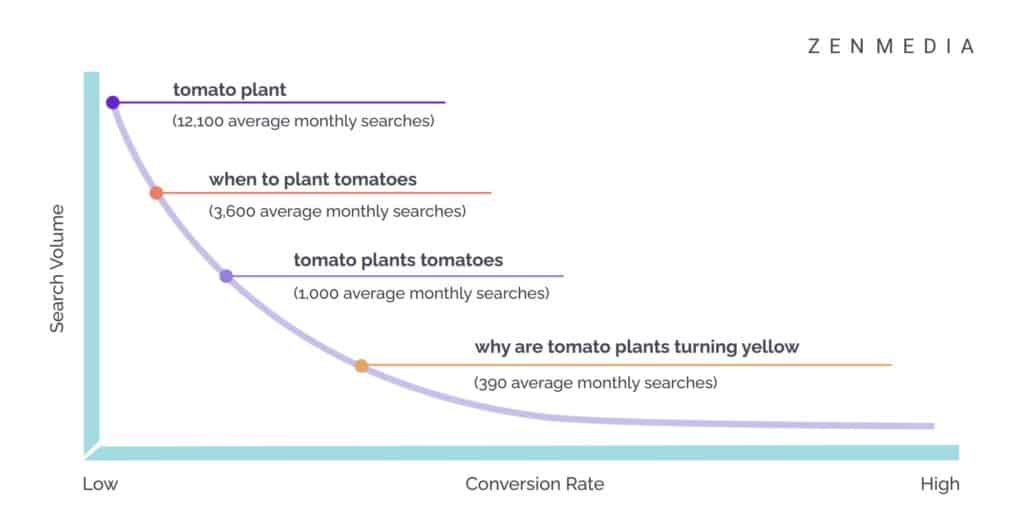
When a keyword is included in a specific phrase—such as “How do I market my B2B tech company” or “Why is B2B tech a growing industry”—these commonly searched phrases are called long-tail keywords. Motivated buyers will more than likely take the time to make specific search queries. When they do this, your page could be the most relevant for the search result.
5. Incorporate Low-Volume, High-Value Keywords
For better or worse, B2B brands have a smaller field to pull from when it comes to keywords to rank for. In the B2C market, ranking for certain short-tail, high-volume keywords may be necessary for a brand to achieve growth. However, in the B2B marketing realm, your audience is smaller, which means that extremely high-value keywords may also be long-tail ones that have a lower search volume. The bottom line is that relevance is what attracts buyers in B2B, so that should be the principle guiding your keyword research.
6. Identify The Difference Between Keywords and Buzzwords
Keywords and buzzwords are some of those things most B2B companies misuse when it comes to strategy. Buzzwords are things like product names, technical terms, or synonyms, and placing too much attention on them can be damaging if they aren’t the same as the string of words your buyers use.
Therefore, it is always better to use keywords despite how good you might expect your product name or brand wordsmithing to be. In the end, buyers will not make the effort to search for something worded in a complex way. We’d all rather type something simple into a search engine when we’re trying to find something. So keep it simple!
7. Choose Keywords For People, Not Businesses
Just like your content team knows to write for people, not Google’s robots, your SEO efforts should be aimed at the individual people you’re trying to reach—not the industry or businesses. To do this well, you have to know who those people are and what they need. Presumably, this is something you already have a fairly good understanding of from market research, your zero-party data, and/or buyer personas.
If your audience consists of CTOs who are looking for a cloud-based CRM with specific integrations, you’ll design your SEO keyword research strategy around those terms, along with the pain points that your audience has. This results in keywords like “fastest CRM” or “CRM with Mailchimp integration.” This is different from focusing on a type of business or industry, like e-commerce or medical offices. If you were targeting the business or industry instead of the individual people, your keywords would look entirely different (and they wouldn’t be nearly as effective).
8. Conduct Gap Analysis
Keyword gap analysis is often overlooked for other B2B SEO strategies, such as keyword research and backlinks. However, keyword gap analysis is a must-have if you want successful intelligence on your competitors. It allows you to compare your keyword ranking to another competitor’s domain ranking. This helps with figuring out any opportunities you may be missing or any gaps in your strategy.
A keyword gap analysis is not hard to pull off. There are many tools out there, such as SEMrush and Ubersuggest, which allow you to input your competitor’s domain and view everything from what keywords they’re ranking for to how much traffic they’re receiving and what their top pages are. Once you have this information, you can discover ways to improve your own B2B SEO.
9. Create SEO-Optimized Landing Pages
Optimizing landing pages is the epitome of SEO strategies. It is essentially what makes or breaks the number of leads you garner. Creating landing pages is not difficult at all and requires only a few steps. Key elements of an optimized landing page should begin with a catchy and effective headline that relates to your CTA and then an offer with a brief description of its benefits.
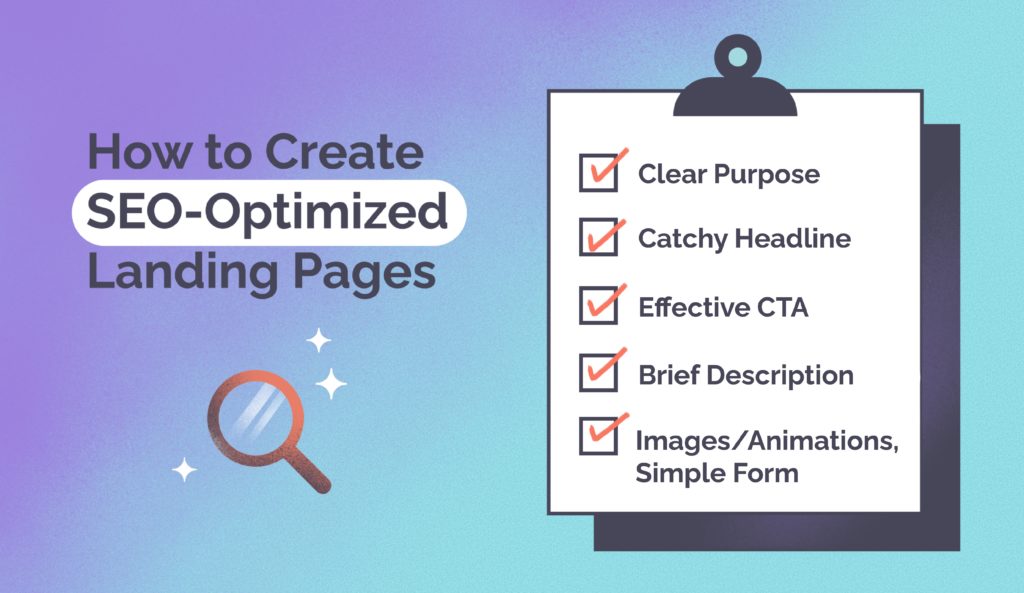
Each landing page on your site should have its own purpose. If you attempt to sell your visitors multiple things on one landing page, they can get confused, and that will lead to the loss of leads.
Once you’ve determined your purpose, you can utilize images, logos, or even animations to bring your page to life—but make sure to keep it clutter-free. A cluttered page can make the content unclear, distract customers, and ultimately lead to lower conversion rates. So try to be brief, not boring, and don’t forget to emphasize the benefits you are offering.
Lastly and most importantly, you must have a well-optimized form that captures your visitors’ contact information. It’s best to keep it short and simple by asking for their name and contact information. Visitors don’t want to fill out a ten-question-long form, so keep it simple!
PART 2: OPTIMIZE!
10. Implement Structured Data On Your Site
Structured data helps search engines understand what information is available about your website. This includes things like product names, descriptions, prices, ratings, reviews, etc. Search engine algorithms use these signals to determine how relevant your site is to a particular query. If your site has structured data, then it’s easier for Googlebot to crawl and index your pages.
Once Google understands what your webpage is about, the more users will find your business when searching for related services and products before your competitors.
11. Optimize Your Pages’ Metadata
Metadata refers to your site’s meta description and title tag. The latter is the most important ranking factor in search engine algorithms. It is also the title displayed to users in search results. Titles should be kept short, and importance should be placed on the words at the beginning of the title, so it’s best to use target keywords and keep it simple.
The meta description shows users a snippet of what the web page is about. Meta descriptions are not a ranking factor, but they are an important SEO factor. They can have an impact on how your pages appear in search results and how many users click them. A search engine looks at the meta description for keywords. If your meta description contains the keywords a user searches for, then you can control what search results look like. If not, then that snippet is left to the search engine, and results are often slim.
12. Name Your Image and Add Alt Text
Alternative text’s main goal is not SEO. Alt-text is foremost included for visually impaired users so that they can better understand your site. However, keywords can most definitely be incorporated into image alt text.
When writing your alt text, keep it short yet descriptive. Avoid keyword stuffing, but use enough description to make sure readers can imagine what the image looks like and its context in the piece. We recommend adding in a keyword or two in addition to the 2-4 descriptive words. In terms of SEO, web crawlers cannot “see” images, so adding alt text with keywords helps crawlers understand and rank your page.
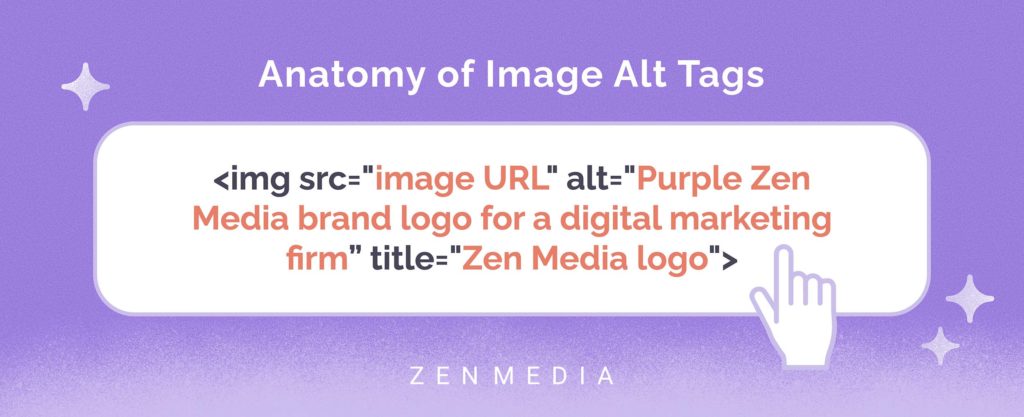
For example, a bad alt text for an image of Zen Media’s logo would be “alt= Zen Media brand logo Dallas digital marketing tech public relations firm.” This alt text has way too many generic references to Zen Media. Stuffing your alt text with keywords is not helpful to web crawlers and SEO.
Instead, a good alt text would look like this: “alt= Purple Zen Media brand logo for a digital marketing firm.” This alt text is much better because it’s descriptive in the right way and is not stuffed with keywords that can throw search engines off.
13. Don’t Neglect H1 Tags
H1 tags are often pushed to the side as a menial task, but they hold a lot of impact on SEO. H1 is the HTML tag applied to the most important and biggest title on each web page. Search engines use the H1 tag as a ranking factor when figuring out what your page is about. There should always only be one H1; multiple on a single page or a missing tag can negatively affect your SEO ranking. Don’t forget to make sure your single H1 contains target keywords to improve your ranking!
14. Keep Titles Under 60 Characters
A long title is never a good thing. It’s not SEO friendly, and it’s not user-friendly. For a post that will surely get you views, opt for a title under 60 characters. This way, when a user searches for something related to your post, the entire title will appear in the search result rather than one that cuts off mid-sentence.
15. Improve Page Speeds
Page speed matters tremendously in B2B SEO, so it is something you cannot, and do not, want to ignore. Your content may be the best out there, but if it takes forever to load, then your ranking potential will fall dramatically. A slow page is the worst thing that can happen from a user’s perspective, and if your page doesn’t load in the first few seconds of opening, the user won’t hesitate to leave.
If you don’t know where to start on fixing your page speed, consider optimizing images, enabling browser caching, and reducing server response time. If you need more help, there are many tools out there to improve page speed, such as GTMetrix or Google PageSpeed Insights. Speeding upload time can be confusing, but it will ultimately improve your overall B2B SEO.
16. Optimize Your Site For Mobile
Mobile users make up the majority of search engine users, so, to rank as well on Google’s mobile-first index as you do on desktop, your site must be optimized for the mobile experience. You can begin with small but impactful changes, such as testing your site to see if it’s mobile-friendly. Filling out a form, checking out, or starting a chat should be as fast and reliable on mobile as it is on a web browser. You also want to make design tweaks to ensure all your calls to action are visible and where they need to be to maximize mobile conversions. If these features aren’t responsive on mobile, they will significantly reduce your mobile leads.

When considering your next design change, prioritize having a mobile-responsive, mobile-friendly website and you’re sure to see improved organic search rankings on Google’s mobile-first index.
17. Every Successful SEO Campaign Begins With a Solid Website Foundation
A solid website foundation is what makes your B2B SEO strategy successful. Working on user experience means simplifying tasks for potential customers who, when done right, could become returning customers. Some ways to invest in user experience include creating easy URL structures, placing content on both the top and bottom of the page, and developing strong internal linking that helps users navigate from page to page.
Outdated information isn’t useful to anyone, and if users realize your information isn’t up-to-date, you are bound to lose their trust. Set a schedule and keep up with creating and publishing new content to keep potential customers educated, informed, and engaged.
You want to keep the visitor as long as you can by providing an excellent user experience. The longer a visitor spends on your site, the more confident Google is that the information found on this site is relevant and engaging, which will boost your rankings.
18. Avoid Keyword Cannibalization
Keyword cannibalization is when a site has more than one page focused around the same keyword, which can really tank your SEO efforts. When this happens, Google has to choose between the best page for a search query, and it may turn out to be the page you don’t want. Keyword cannibalization can also mean poor content quality, low conversion rate, and diluted internal and external links. Something as small as duplicate title tags in the meta-information, targeting the same keywords, can cause Google confusion. Organize your site structure and keep keywords at one per page.
19. Build A Link Lattice
A link lattice is a series of interlinked pages around your product category. This is a great way to begin the technical side of B2B SEO. If your site is fully functioning with great content, you now need Google to recognize that you created something that will satisfy your audience and the keywords they use. You can do this by connecting your product pages with pillar pages and other page types. By doing so, you are telling Google which pages are more relevant to the product category, and Google will then rank for that search volume.
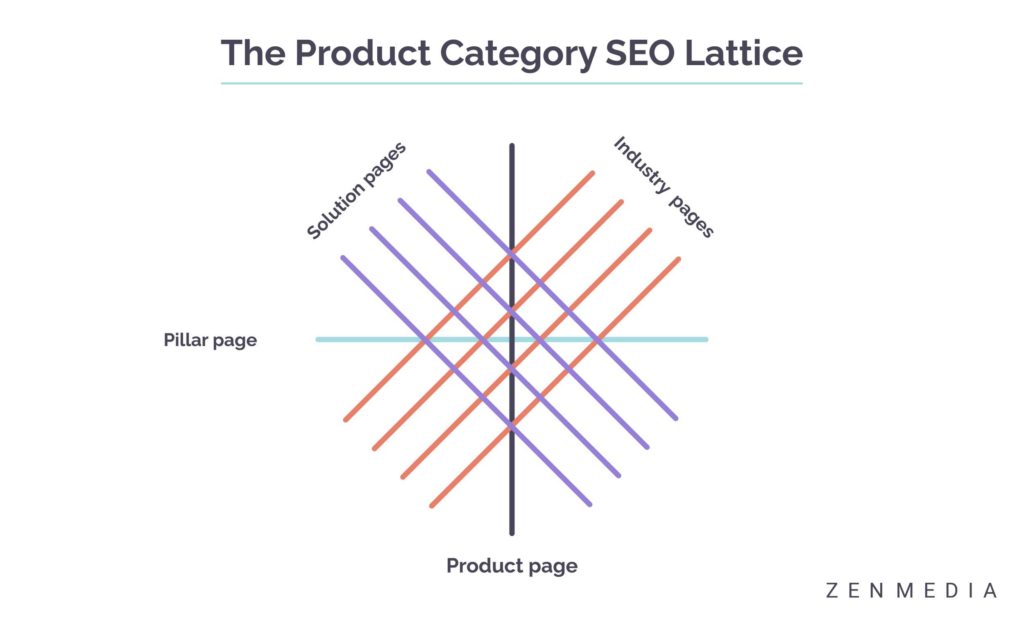
20. Use Video
Video marketing has made a name for itself in the past few years, and B2B businesses are jumping on the bandwagon to take their strategies to the next level. Videos today are designed to influence the savvy modern buyer, and companies using this tactic are seeing lead generation and new customers. They do a great job of enhancing a company’s site, adding interest, and influencing potential customers.
The best part of video marketing? It can be used for almost every part of the sales and marketing process.
But, real talk, creating compelling videos isn’t easy; it requires the same amount of attention and effort as any other type of content marketing—so don’t phone it in! A low-quality or boring video does nothing to help your brand.
PART 3: BUILD YOUR BACKSTORY
21. Create Infographics
Not only do infographics boost your own content and give your posts more depth, they can also be shared among different audiences and platforms. Infographics inspire readers to share posts because they contain digestible nuggets of information in an aesthetically pleasing way. And when your graphics are shared, you receive a backlink, which helps with your website’s rankings.
22. Create FAQ pages
FAQ pages are a wonderful resource to add to your website. You want to house all frequently asked questions in one central place for users to find easily. This is a great way to enhance the user experience and provide clarity. Linking to the FAQ page on blog posts that talk about offering options or complex product information helps ensure that users get their questions answered.
And don’t forget, these strategies are meant to work together—so consider adding videos or interlinking to your FAQ page to ramp up SEO efforts.
23. Have a Topic Funnel
Creating a topic funnel allows you to create optimized content that speaks to different consumer needs. When creating a content funnel, focus on user intent. Why are people reading your content? What is the goal of the content you’re creating?
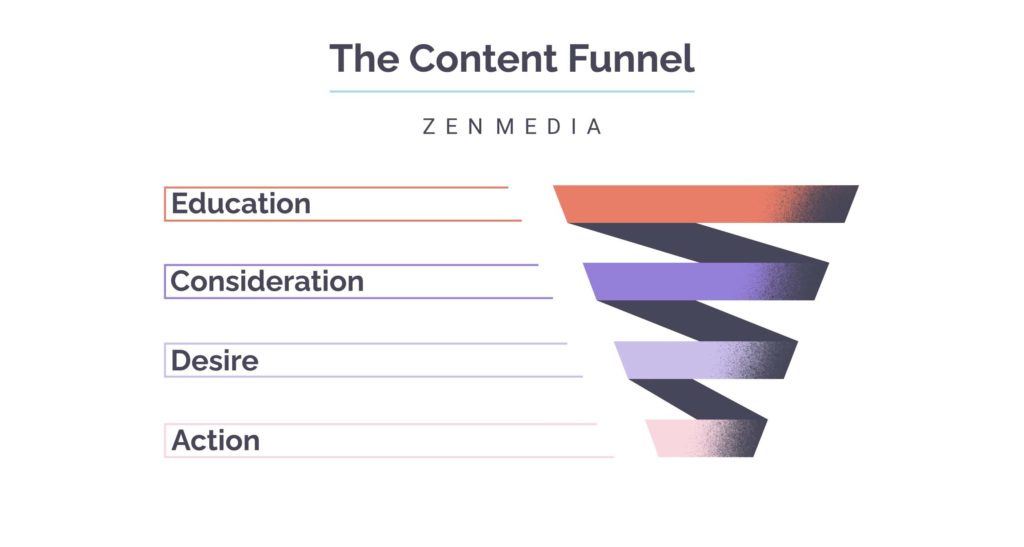
There are four main sections in a content funnel: Action, Desire, Consideration, and Education. The larger end of the funnel contains content that has an educational and informative intent. This content is meant to reach a large and varied audience. The main goal of B2B content is to maximize SEO efforts, increase website traffic, and ultimately increase conversions. Once you draw people in with broad content, you can begin to narrow down the topics. The smaller end of your content funnel will contain more actionable content to get those conversions.
If you are unsure about how to prioritize what you want to talk about, break it down into levels. First, decide which topics you want to cover at the highest level. This will be the foundation for your funnel. Next, get the keywords for all of your topics and categorize them. Last but not least, organize your keywords based on the marketing funnel stages. Don’t forget to tag all of your keywords and sort them by where they are in the funnel. This strategy enables you to prioritize topics both by where they are in the funnel and by their average search volume.
If you’d like, you can take your analysis a step further by evaluating topics and funnel stages by location. This method will help you identify where your existing content sits in the funnel and where there are gaps to fill.
Remember the difference between topics and keywords! The topics that you add to your funnel will stem from your keyword research. You want topics that your keywords can easily be incorporated into. Don’t fall for the lie that they are one and the same!
24. Refine Your B2B SEO Strategy to Reach Multiple Audience Groups
Since B2B buying groups are made up of multiple people, often from multiple departments, you’ll need your B2B SEO to help you reach all of them. For each person or persona you’re trying to reach, generate content and keywords that address:
- Pain points: What do they struggle with? What problems need solutions?
- Needs: What do they need from your product or service? Why are they searching online?
- Location: Do buyers in different regions or countries have access to different types/groups of your products?
- Hopes and dreams: What would the ideal outcome from purchasing your product/service be for them?
- Frequently asked questions: Each individual in a buying group will have different questions, and it’s your job to anticipate and answer them.
Considering these questions when creating content will ensure that you reach a large audience of B2B buying groups.
PART 4: CREATE CONTENT
25. Form Content Clusters
Content clusters are similar to the concept of creating topic funnels. However, while funnels focus on user intent, clusters look more at keywords and certain blog topics. Content clusters should be centered around your target keywords and B2B buyer personas. They are a great way to organize content ideas and provide a place to turn to when you’re having writer’s block. If you want to post a blog revolving around one of your keywords—turn to your content clusters for ideas.
26. Build Authority and Credibility with Blogging
To make the most of your B2B SEO efforts, blogging will become your best friend. Blogging is the best way to establish your business as a thought leader and lend credibility to your site. And we get it; writing is time-consuming and can be challenging, so you may be tempted to post every other week—but consistency and volume are key. Aim to post twice a week on your website’s blog page to show Google that your site is active and relevant, improving your ranking and helping you reach more people.
Frequency isn’t the only thing to worry about when blogging. Your blogs should be at least 750 words (though posts that contain at least 1,500 words will, on average, perform twice as well!), contain original content, include relevant images (don’t forget the alt text), and be packed with keywords. Original or non-copyrighted graphics also add dimension to your posts and allow for a better reader experience. And don’t forget to interlink!
Blogging, along with link-building, should be the backbone of your B2B SEO strategy.
27. Reference Authoritative Sites in Your Blog
Referencing other authoritative websites in your blog posts boosts the credibility and trustworthiness of your website. There are established websites that are known as experts in every single industry. Linking to these sites not only gives your reader additional content to reference but also helps establish your website as a place where reliable content can be found.
Before linking to a web page, check the domain authority (scale is 1-100 with 100 being the best). Any score above 40 is typically considered average or good; above 60 is considered excellent! Don’t fret if you link to a post below 40. You’re really just looking for established sites that are well known and hold some sort of credibility.
28. Produce Long-Form Content That Captures Your Share of Voice
Long-form content is a powerful aspect of any B2B SEO strategy. It refers to any piece of content that exceeds 2,200 words. Long-form content can include ultimate guides, case studies, tutorials, and even non-written content like videos and podcasts.
Transcribing videos is extremely beneficial for SEO. Transcripts lure in search engines with relevant keywords. Search engines like Google can’t watch videos, but they do index text. Therefore, a transcript enables them to ingest your content and index it accordingly. You can also add closed captions which can allow you to rank higher in search results. They can also increase viewership because the viewer is kept engaged by them. Not only do video transcripts align with your strategy, but they make creating and repurposing content easier. Content marketers can utilize transcripts as a stepping stone across multiple channels that will further help your site gain a presence and reputation.
When producing long-form content, it’s important to make sure that it captures your share of voice (SOV). SOV is what measures brand awareness and includes the number and reach of online mentions, website traffic, and more.
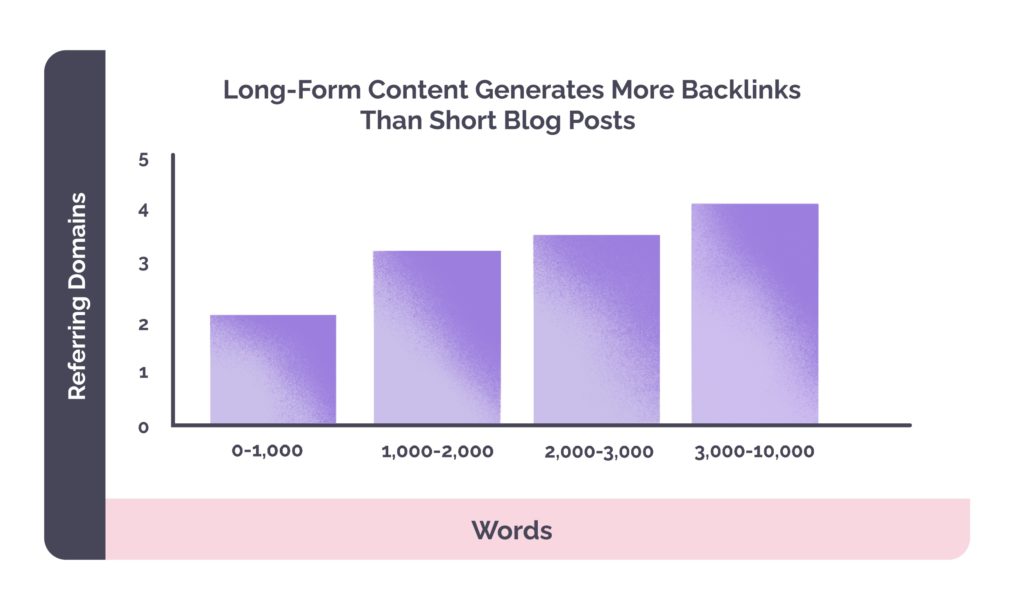
To put it simply, your SOV is what helps you understand how popular your brand is in comparison to your competitors. To produce long-form content that captures your SOV, focus on consistently publishing insightful content that keeps readers engaged and wanting more. This builds trust in your brand, establishes credibility in comparison to competitors, and makes people more willing to do business with you.
Another way to capture your SOV in your content is to use social media, participate in consumer conversations across multiple channels, and experiment with making videos that provide a closer look into your brand and how it measures up to competitors. Whatever long-form content you decide to create, remember that the best content captures your share of voice, and is engaging, consistent, and made with a purpose.
29. Stress Quality Over Quantity
While you do want to aim to post at least two blogs per week, this doesn’t mean you can phone it in. Don’t become so focused on your posting schedule that you begin to produce sub-par content. Everything you post needs to be high quality to ensure that you maintain credibility.You want each blog post to have a good amount of high-quality and well-written information, so if you need to pair back to one post per week to keep quality high, do it!
Google can pick up on keyword stuffing and low-quality content — so can readers!
30. Format Your Content for the Reader
We’ve said it before, and we’ll say it again: Content is a huge part, if not the most important part of your B2B SEO. And it must be easily accessible to users. Most people spend less than a minute on a web page before leaving, and it’s your job to make sure they stay. By publishing content in an organized manner with plenty of line breaks, white space, properly formatted section headers, tables of contents, and appealing on-page elements (graphics, for instance), users are more likely to not only notice your content, but also read it, and hopefully share it.
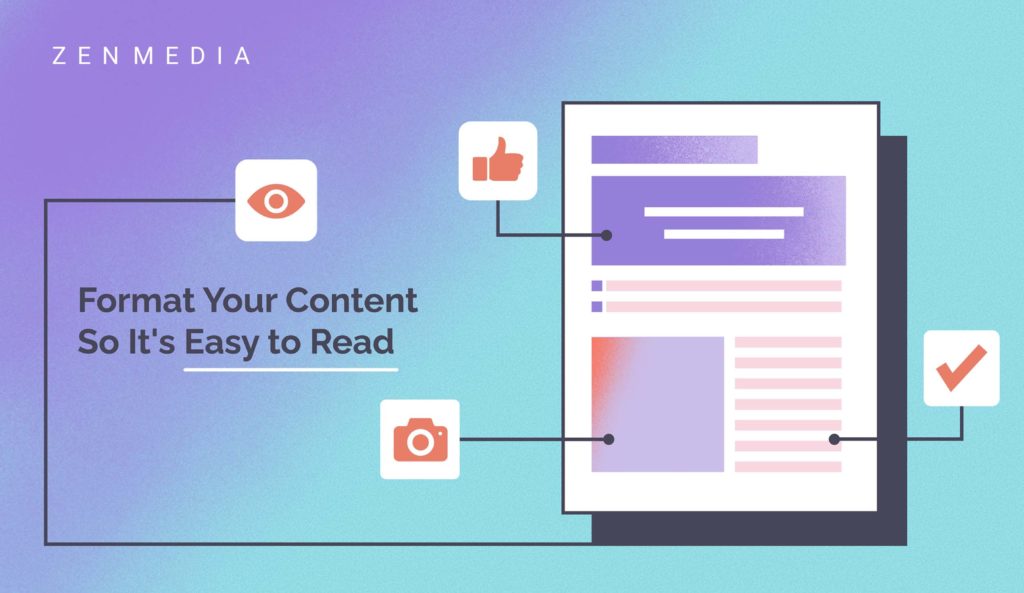
31. Strategically Position Your CTA In Your Content
If you want to see conversions from your content, then CTAs are a must. Implementing CTAs throughout your content is a great way to persuade visitors to take action before they can leave the page. However, since not everyone on your site is there for the same reason, it’s best to have multiple CTAs. The strategic way to sprinkle them throughout your content is on the side of every page and at the end of every blog post.
Visitors should know where to click to move down the content marketing funnel with little to no effort. The sidebar CTA is the most common and works well if it travels down the page as the visitor scrolls. The end-of-page CTA should not appear abruptly or be disconnected from the content; it should fit organically and feel like a natural end to the piece rather than an advertising banner.
By including these CTAs strategically throughout your website’s content, you will slowly but surely see a rise in conversion rates and captivate your target audience.
32. Create A Content Calendar
Yep, we know: Staying on top of a huge amount of content is no simple task. This is where a content calendar can come in handy. There is a huge SEO benefit to producing content, and it’s much easier to do it consistently with a plan in place. So help yourself out and map things out before you’re staring at a blank Google doc.
Case studies, long-form pieces, and cornerstone content can take a while to draft, which is why a content calendar that intersperses shorter pieces with longer pieces can help the content machine run smoothly. That way, marketers can focus on their SEO efforts and know that content is consistently being pushed out.
33. Create Evergreen Content
Your content should be like The Beatles—evergreen. Essentially, regardless of what is going on, your content should be relevant. It should stand the test of time.
Topical content is also useful and sometimes necessary, but for the most part, you want to create content that can be updated frequently and without a ton of work. It can be difficult to change URLs once a post is live, so pick URLs that are adaptable. Leave out numbers and dates (years), so your post can live on. If you create an article with five tips, you want to be able to go back and add more tips if some ever cross your mind.
Evergreen content allows you to make changes when needed, no matter how long ago you created it, and will also be relevant to users at any time.
34. Leverage AI Marketing to Repurpose Old Content
While creating new content is important and helps establish your brand as a thought leader, it is also essential to go back through older content and revise. Repurposing content keeps all your content relevant to readers.
An overflow of content is much less desirable than repurposing old content. This doesn’t mean going back and updating dates and stats, and adding new information to your existing content. Repurposing means completely updating the format and altering its purpose. It comes in many forms. For example, you may want to turn a blog post into a whitepaper or combine several pieces about the same theme to create an even more extensive final draft (and remember, long-form wins! Three 800 posts will do much better as a single 2,400 word piece).
Plus, it’s much easier jumping off of existing content than coming up with something completely new. You want to work smarter, not harder, right? Leverage the rise of AI in marketing and utilize AI tools to help you find ways to repurpose it before jumping to producing new content.
35. Establish Thought Leadership
Establishing thought leadership ties into creating original content. You want to establish your brand as a knowledgeable authority in your industry. When people have questions that need to be answered, you want them to turn to your website first.
By producing content, such as blogs and videos that are full of valuable information, you begin to establish thought leadership. Contributing to valuable posts on other websites will also get your name out there as a credible and reliable source. Becoming an authoritative source may take some time, but stick with it, and you’ll see vast improvements in your B2B SEO efforts.
36. Focus SEO Resources on Brand Building
Google gives strong brands preferential treatment. So, if you don’t already have a well-defined brand, it’s time to make one.
To build a brand, you need a brand story that’s told with target keywords. Once your brand is out there, you can shift your focus to gaining natural links, positive user behavior, and optimized pages and content play, which will further establish your brand.
Don’t get discouraged if your brand journey takes a long time. Trust and credibility are not built overnight. Establishing a brand as an authority takes a lot of patience and effort, but the end results are well worth the wait.
37. Don’t Neglect YouTube
One thing businesses tend to forget is that YouTube is a search engine too! It is often neglected for written content, but for a hard-hitting B2B SEO strategy, YouTube is your friend.
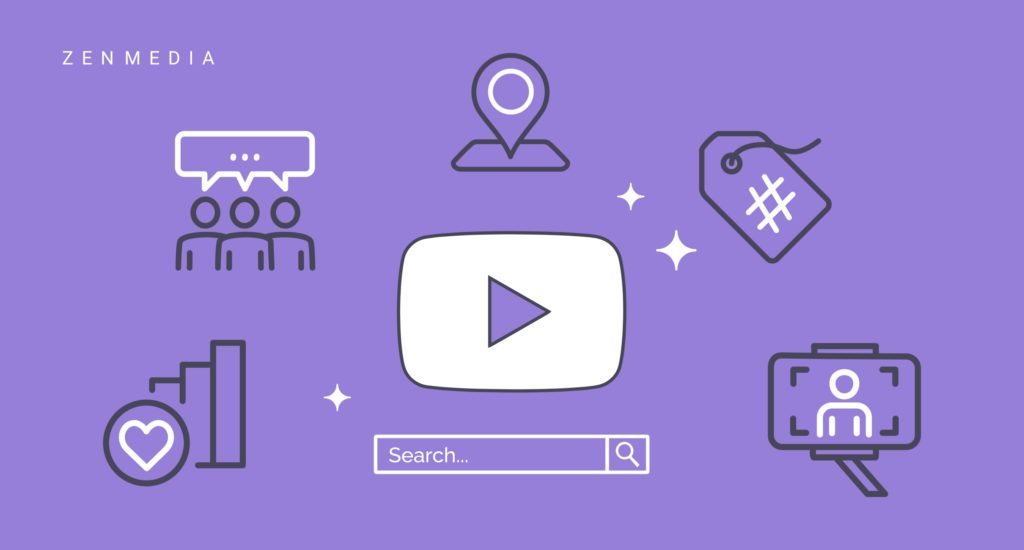
Repurpose blog content and high-performing SEO posts by turning them into videos. And if you want to take it a step further, mull over the idea of making videos that cover the same topics as your competitors’ blog posts and articles. Since people are more likely to click on a video than read a blog, repurposing competitor blogs as videos can give you a leg up in the marketing game.
Now, you can’t just go and post a video on YouTube and expect to see results. You have to make sure your videos are properly optimized in order for them to pop up in Google search results. Optimizing your videos includes adding keywords to your description, title, and video file, including relevant YouTube hashtags in your description, and selecting a video category that reflects your video’s content. Not only will optimized videos show up in search, but they will also make a great addition to your blog, social media, and website content!
38. Tap Into The Power of TikTok SEO
Similar to turning blog content into YouTube videos, businesses can repurpose blog content and YouTube videos into TikTok content. Not only is TikTok a search engine, but the number of users turning to TikTok to search things instead of Google or YouTube is growing daily.
With so many users turning to TikTok for discovery purposes, businesses can utilize TikTok SEO to drive organic traffic and leads to your site. Like YouTube, you can’t post a video and expect people to find it. Make sure you find out what keywords people are using to search for your video, speak those keywords in your video content, and include hashtags relevant to those keywords in your TikTok description.
39. Focus On Off-Page In Addition To On-Page
On-page is, of course, a large part of your B2B SEO. But as you are optimizing your web pages and blog posts, be mindful not to neglect off-page efforts.
Off-page SEO includes obtaining backlinks to your website, creating shareable content, and social media. Basically, anything that happens off of your web pages. Once you’ve spruced up your site, focus on getting links to your website from other websites with a high domain authority and lots of organic traffic.
40. Combine PR And SEO Efforts
So, which off-site website do you want to appear on? Having a comprehensive PR plan and strategy that helps you get placements in top-tier and industry-specific publications will not only help build your authority, it will also build your SEO. You are trying to prove to search engines and readers that your site is trustworthy, relevant, and that you (or your company) are an important figure in your industry. This is what public relations is all about, so pairing the two is the perfect way to build your reputation while improving your rankings.
Further benefits include more social media engagement, more visibility, and a broader reach. Search engines may grow and change, but off-page SEO will always be an integral part of any strategy.
For even more visibility, when your PR team lands Tier 1 press with outlets such as Forbes, Business Insider, and Thrive Global, you can incorporate a paid ad campaign around your recent press coverage to amplify these mentions. A paid ad campaign is any kind of advertising that you have to pay for. You can begin your own paid ads campaign in a few easy to follow steps.
First, begin with an objective and get to know your audience. This will affect your ad options so make sure to choose carefully. Next, pick the right social media platform for your campaign based on your audience’s demographics. You can then take an even deeper dive and decide who you want to target based on your audience’s interests, age, location, and more. Before implementing your campaign, you’ll want to first put all targeting tools like Google Analytics tracking in place. Once you’ve built that foundation, you can go on to choose the best ad format for your campaign. You can choose multiple social media ad formats to help reach your objective. Now, you can move on to the thick of it. This is when you create your campaign content. You can use A/B testing to see if the content is reaching your target goals once the campaign goes live. Last, but not least, set a budget for how much you want to spend on your campaign this month and optimize to get better results!
41. Regularly Conduct Broken Link-Building Campaigns
Broken link-building is an off-page B2B SEO strategy that can help you and the site with the broken link. The technique consists of reaching out to webmasters to suggest backlinking to your site rather than continue to house a broken link.
Broken links can occur for many reasons, such as the destination website removing the linked page, the destination website moving or no longer existing, and more. Whatever the reason, broken link campaigns are an easy way to build more backlinks with little effort. Since broken links can harm a site’s SEO, you’re also helping the site with the broken link. (And it’s important to mention this key point to webmasters when pitching to fix broken links!)
To run a broken link campaign, you can use auditing tools, such as SEMrush or Moz, to find out what broken links your site has on external pages. You can also use these tools to search your competitors’ domains and find broken link opportunities through them.
But you don’t want to put links to your site on any old website. It’s essential to remember that the sites you are building links from should be relevant to your own.
When done correctly, you will start to see an increase in your website’s authority and organic traffic, which can be used to grow your online presence.
PART 5: MAINTENANCE
42. Recover Lost Links with Link Reclamation
Other sites are linking to your web pages. Great, right? Yes, as long as those links are working properly. Every few months, you should take a look at all of the backlinks your site has received. If they are anchored to the wrong text or don’t provide a positive user experience, get in touch with the page’s owner and see if they can make changes. It’s usually much easier to get a website owner to fix a broken link than it is to convince them to add a totally new backlink. And link reclamation not only enhances the user experience on their site but also benefits your SEO efforts. It’s a win-win for both websites!

43. Set Up Google Alerts to Discover & Claim Unlinked Brand Mentions
One of the benefits of creating high-quality content is people will begin to include your brand, products, or services in their own content. Generating brand mentions will enhance your online presence and build your authority—specifically if they include a link back to your website. Unlinked brand mentions are missed opportunities for backlinks which, in return, are missed opportunities to boost your reputation and rankings.
Luckily, you can monitor any mentions of your brand name using Google Alerts. Set your brand name as the target phrase to track in Google Alerts, and Google will send automated alerts whenever web pages mention your brand. Then, you can identify which pages include unlinked brand mentions and reach out to the site author or company to add your preferred link to the post.
This is one of the most effective ways to identify new link-building opportunities and earn valuable links to drive traffic to your site.
44. Implement an Ongoing B2B Link-Building Campaign
Linking your site back to high-quality and reputable sites in the industry can be done in multiple ways. One option is to do manual research and find sites to build backlinks to your own, potentially driving traffic. Another is to guest post, which should be done in a considered, strategic manner.
To effectively guest post, follow all of the editorial guidelines, pitch relevant content ideas, and avoid the risk of getting penalized by Google.
If you’d rather use a tool, then HARO is a free resource that can put you in contact with some major publishers looking for pitches.
45. Disavow Toxic Backlinks
Toxic backlinks are unnatural links that can harm your website’s search rankings. These links are almost always inorganic or have been purchased from shady, untrustworthy SEO sites.
To disavow these kinds of links is to address penalties imposed against your web property. Since toxic backlinks can cause what is called a negative SEO attack, it’s important to understand how to carry out disavowing them—it’s a serious action that can significantly affect your rankings. Therefore, you should only disavow links that you know are negatively affecting your site. Disavowing is essentially requesting for Google to ignore those toxic backlinks to your domain.
Google itself has a Disavow Tool, which can be accessed through the Google Search Console. You can use the SEMrush audit tool to find the links you want to disavow, then input the link into Google’s Disavow Tool. Blacklisting the entire domain is much easier than listing each URL. Once you upload your list into the Disavow Tool, all you have to do is wait a day or two, and Google will no longer take the listed domains into account when deciding your pages’ rankings.
46. Ramp Up Your Internal Linking
Internal linking is an integral part of your on-page B2B SEO strategy. The goal is to get people to stay on your website for a longer period of time. Use Google Search Console to analyze keyword metrics, such as impressions and clicks. Once you figure out which keywords are likely to get clicked on, incorporate them into your blog posts. Use these chosen keywords as anchor text to link to other pages of your website. For example, if you have a page on your website detailing B2B SEO, link that web page to the keyword ‘B2B SEO’ in one of your blog posts. Not only does this get people to stick around, but it also helps link your web pages to your targeted keywords.
47. Stay Up to Date with Google Algorithm Changes
Search engines change all the time. Despite how much marketers do on their part, Google will continue to do whatever it wants. It may destroy your keyword strategy, push outdated information, or display your product in the title tags. When something like this happens, it’s important to be aware of the changes and try to understand why. For example, when it comes to the product name and title tag issues, it means that Google has decided that a word you view is integral is not—and is focusing on something else instead. As B2B marketers, we know that’s not right, but a search engine doesn’t, so it’s important to keep an eye out for any developments or adjustments.
48. Leverage Google Search Console to Monitor Your Site Health
Your core web vitals fall into the more technical side of the strategy, but they are still just as important as the rest. These vitals are the set of metrics Google uses to let developers know how users are experiencing their pages. The three core vitals include:
- Largest Contentful Paint (LCP), which deals with page performance and speed;
- First Input Delay (FID), which measures your website’s responsiveness; and lastly,
- Cumulative Layout Shift (CLS), which measures the stability of elements on your page when scrolling. This is where Google Search Console (GSC) comes in. It can be used to check your site’s health for potential issues that Google has detected, evaluate your organic search traffic, and address security issues.
GSC tells you how Google sees your website and provides insight into the pages of your website that are having problems being crawled or that are being indexed, who is linking to your website, the most popular keywords, and more. Getting these vitals right is an important element of how you rank on Google, so sorting it out now can benefit you tenfold in the future.
49. Regularly Crawl and Fix Website Issues
To ensure that your website is functioning at optimal levels, it is a good idea to invest in a crawler to regularly audit your site. Put simply, a crawler is a bot that looks over all the content on your website and indexes, or ranks, your web pages in search engines.
The crawler will go through your site and flag issues as it spots them. You will be provided with insights on SEO health and visibility, along with issues such as duplicate content, broken pages, flawed titles, and more. Screaming Frog is a great example of a fast, industry-leading crawler that improves SEO by extracting data and auditing for any issues.
You can also use Google Search Console to recrawl your website. This means that if you have updated your site’s previous issues, you can let Google know by submitting URLs to Google’s crawl queue and adding a sitemap that contains URLs that you want Google to crawl and index.
A sitemap is essentially where you provide information about the pages, videos, and files on your site. By creating one, search engines can read the file to crawl your site more efficiently. For example, a sitemap tells a search engine like Google which pages and files are important in your site and provides valuable information on them.
50. Track Progress to Make Necessary Changes to Your Strategy
If you don’t track progress, then you won’t see change. In order to improve, we must first understand what is working and what is not. Tracking ranking, conversion, lost links, and more are all factors that go into a successful B2B SEO strategy. Google Search Console is a great tool to pick up on and notice these changes right away. It allows you to track important metrics such as the number of clicks and keyword positions. For example, if you are not ranked first and have been stuck in a certain position for several weeks, it may be an indication that your content is not of high quality, is less detailed, or that you don’t have sufficient authority.
Google Search Console also tracks impressions, which is the number of times your website has been seen, as well as click-through rates, which is the ratio between the number of clicks and the number of impressions. It’s important not to ignore any errors that GSC may bring forth. Whether they are big or small, it helps to understand the reason for the change so you can pivot your priorities to fix what isn’t working. A successful B2B SEO strategy isn’t made overnight. You have to put in the effort, time, and in-depth analysis to learn what works with your business and what doesn’t.
51. Be Consistent
Consistency is key and it’s what keeps your B2B SEO alive. If you want to continue seeing high search rankings and increased conversion rates, then you want to keep your SEO efforts consistent across all platforms and mediums. This entails regularly crawling your web pages for errors, frequently updating content, posting new content often, maintaining link-building efforts, and keeping up with analytics tracking.
If you aren’t aware, Google has a “Freshness Algorithm” which means staying consistent with content is essential in moving up on the SEO ladder. Publishing is also what makes your brand more trustworthy. By updating content on a consistent basis it indicates to your audience that you can be trusted in your profession and industry. It will also establish your brand as a credible and relevant place to find information online.
A great way to stay on top of your SEO game and utilize data in your strategy is by leveraging Google Data Studio. GDS is a free tool that turns your data into easy-to-read, customizable reports and creates shareable visual dashboards. This data can help you and your team understand which pages and keywords are driving organic traffic and what your competitors are ranking for. GDS can also help you decide what content needs to be rewritten for consistency. You can use the data to rewrite content according to your best practices with the help of a detailed report outlining SERPs such as clicks, impressions, site CTR, average position, and more.
In the end, it doesn’t matter whether you have the best website design or the best products; without consistency, no one will find your site or products. However, by utilizing tools such as Google Data Studio you can speed up the data process time and be on your way to creating top-tier content by creating personalized reports for your brand.
PART 6: CONCLUSION
The perfect B2B SEO strategy doesn’t just include one certain thing. It’s not only about keywords and ranking; it should be comprehensive and multi-faceted.
While there’s a lot that goes into a B2B SEO strategy, the most important detail is continual optimization and link building once you begin your SEO efforts. The best way to make this happen is brand awareness and clarity. Having a clear understanding of your brand and its purpose makes it easier to improve the content, obtain backlinks, increase visibility, and boost organic traffic.
Remember to personalize your B2B SEO strategy and focus on your website visitors and their needs. Track your results via Google Analytics and see what content is garnering the most interest. This can help with future keyword research and content creation!
Don’t neglect linking efforts or outside mentions (i.e., PR) because this is what builds trust and credibility. PR coupled with SEO can lead to outstanding results.
Your strategy may need to change from time to time, which is completely normal.
Use tools such as Google Search Console to track necessary metrics so that you can implement changes when needed. All in all, remember to be consistent and be patient with your B2B SEO efforts to see real organic growth!
Need help with your SEO strategy? Reach out to Zen Media today!



